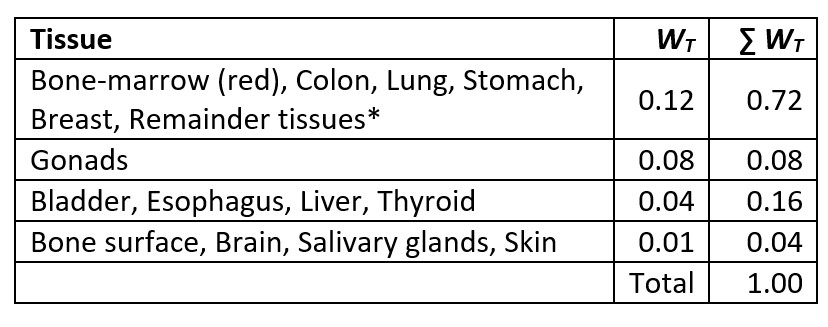Answer to Question #13720 Submitted to "Ask the Experts"
Category: Medical and Dental Patient Issues
The following question was answered by an expert in the appropriate field:
I have done a lot of research on doses from radiation, but I am still a bit confused about whole-body dose vs. organ absorbed dose. Lots of medical journals talk about an absorbed dose to each organ from an x ray or computed tomography (CT) scan, and the dose is different for different organs. My understanding of the reason for the different organs is that the x ray does not interact with the body uniformly. When people talk about radiation from an atomic bomb or background radiation, they refer to a whole-body dose, example 2 Gy. Does that mean every organ in the body absorbed 2 Gy? Or does that mean the dose to all the organs added up comes to 2 Gy? If I had an absorbed dose 0.5 mGy to my brain from an x ray, how does this compare to receiving a whole-body dose of 0.5 Gy from background radiation? Did my brain receive the same amount from the background dose as from the x ray?
The difference between whole-body versus organ-absorbed dose could be the basis for a series of lectures to clearly explain the difference. However, I will attempt to significantly simplify the answer for you. First, I'd like to define the different types of doses. The absorbed dose is the amount of energy deposited by radiation in a mass of matter, tissue in this case. The absorbed dose does vary between organs during an x ray because only some of the organs are in the x-ray beam. There is also some variation due to depth in the body because the overlying tissues absorb some of the radiation before it reaches deeper tissues.
So. what does it mean if you received a 3 mGy whole-body dose from natural background radiation, which is the national average background? A 3 mGy whole-body dose means that the exposure was capable of depositing a 3 mGy dose to tissue 10 mm below the skin's surface. Assuming you were uniformly exposed, this would mean that at any point 10mm below your skin's surface, you received a 3 mGy dose.
To compare the risks from different types of exposures, we use the concept of effective dose. To calculate the effective dose, we multiply the dose absorbed by an organ by the tissue weighting factor for the organ, then add up all of the organs that received dose. The sum of all the tissue weighting factors in the body equals 1. The tissue weighing factor is based on the sensitivity of the organ or tissue to the effects of radiation. We can think of the effective dose as being the whole-body dose that would have the same risk as the nonuniform exposure that was received. The unit for effective dose is mSv.
To calculate the effective dose, you need to consider tissue weighting factors. The International Commission on Radiological Protection Publication 103 has the following weighting factors:

*Remainder tissues: Adrenals, extrathoracic (ET) regions, gallbladder, heart, kidneys, lymphatic nodes, muscle, oral mucosa, pancreas, prostate, small intestine, spleen, thymus, uterus/cervix
If the lung receives 3 mGy absorbed dose, it would contribute 0.36 mSv to the effective dose. The same 3 mGy absorbed dose to the thyroid only contributes 0.12 mSv to the effective dose. If a person receives a whole-body dose of 3 mGy, the effective dose would be approximately 3 mSv.
The risk from an absorbed dose of 0.5 mGy to your brain is much, much lower than the risk from a uniform whole-body exposure of 0.5 mGy.
I am guessing your concern is for your own or a loved one's health due to x rays or CT images. Please remember that if a physician is ordering diagnostic imaging, then there is clinical health information that the physician is seeking so as to provide the best possible medical care in that moment. The risk associated with not completing an ordered exam might have immediate implications to your health. The risk for cancer induction at doses above 100 mSv referenced in numerous studies is just a theoretical, statistical risk, not an expected outcome.
I hope this helps add perspective and understanding to what can be a very complex discussion. If you are interested in more information look at the following websites: Various units of Dose – Animations, HPS Radiation Risk Position Statement, How to Understand and Communicate Radiation Risk.
Kendall Berry, MSPH, CMLSO


